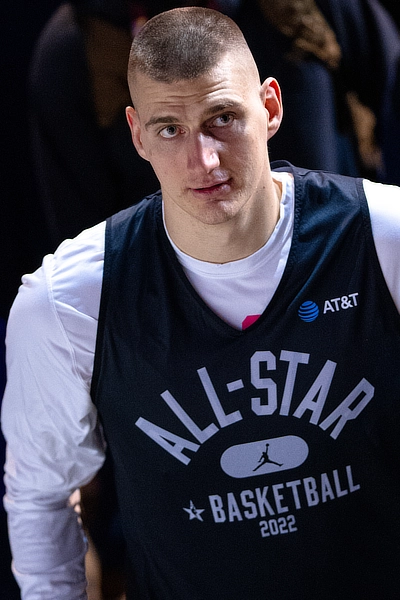
"Nikola Jokic cropped" by Erik Drost is licensed under CC BY-NC 2.0.
Just ask ESPN's 2022 Offseason Survey. No one pegged Nikola Jokic as the best player in the NBA. No one saw him winning MVP. Nobody predicted the Cleveland Cavaliers would land Donovan Mitchell. And when it came to the Denver Nuggets, only one brave soul picked them to win the West—zero to win it all. Fast forward, the Cavs traded for Mitchell, the Nuggets took the title, and Jokic ascended as the best player on the planet.
But hey, don't take just one example. BleacherReport tried to predict the next five NBA champions after 2010. They got one right—one—and that was the 2013 Miami Heat, a team with a superteam that practically wrote its own destiny.
Nikola Jokic? The 3-time MVP? Drafted during a Taco Bell commercial. MJ? Retired in '93 and came back to dominate. Len Bias? Tragically gone days after being drafted. Ralph Sampson and Hakeem Olajuwon? Could have ruled the league if injuries hadn’t intervened. James Harden? Might never have become Harden if he didn't land in Houston.
The truth is, looking ahead in sports is like guessing the weather a year from now. For you to be correct, you assume everything will move in a straight line—no curveballs, no surprises, no injuries. But surprises are what make sports fun.
Who cares if most predictions go up in flames? If you nail just one of these surprises, you get to wear that badge forever. So, here's my shot at finding Who Will be the Most Valuable Player in the NBA in 2029
ESPN's Survey Results
ESPN's offseason survey for this exact question looks like this.
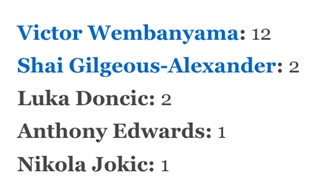
To me, the Most Valuable Player is the one who wins the most—after all, that's what value is, isn't it? But instead of just tossing opinions around, let's dig into the numbers.
For this particular example, I will be using Win Shares from basketball-reference.com. But, what exactly is a Win Share (WS)?
In simple terms, it's a measure of how many wins a player is worth. For example, Nikola Jokic had 17.0 WS in the 2023-24 NBA season, so he was worth 17 wins. The sum of WS on a team slightly deviates from their actual wins. Since the 1962-63 season, the average absolute error is 2.74 wins and the root mean squared error is 3.41 wins.
I crunched the data from HoopsHype's 78 greatest players list. By averaging their Win Shares at different ages, I've created a career template that predicts how much winning you can expect from the best of the best as they age. This gives us a solid framework to measure true value—because in the end, it’s all about winning. It sets a career template, from the meteoric rise to the steady decline. This is what you assume will happen 5 years from now? (barring the surprises of course)

Voila!
Imagine comparing 20-year-old Kobe Bryant to a fresh rookie like Victor Wembanyama. Sure, they might be the same age, but Kobe had already spent a few years soaking up NBA experience, while Victor's still riding high off his LNB Pro A glory. It's like comparing a seasoned warrior to a bright-eyed recruit—the time spent in the league sharpens skills in ways international/college ball just can't. In the NBA, those years teach you things that no tournament ever will. So when we talk about player projections, factoring in that hard-earned experience is the real game-changer.
So, let's create a separate bar graph of Win Shares per year by Experience.
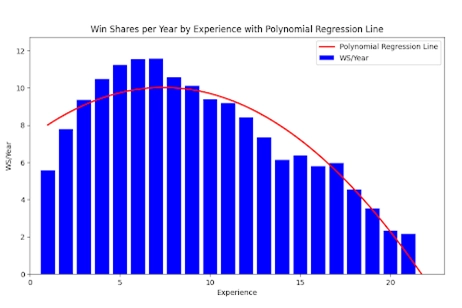
Imagine two 22-year-old NBA players: one is a rookie, fresh out of college, while the other is in his third season, having already faced the grind of the league. Both have the same raw talent, but the third-year player, with his battle scars and hard-earned wisdom, is more valuable. Why? Experience isn't just a number—it's the difference between potential and proven performance.
But, there is a fundamental issue with using something like this. According to a report by Bryant University, an NBA player's prime occurs between their 27-and 31-year-old seasons. Over 58 out of 78 players we looked at entered the NBA after 21 years old. That means, within the 1st 10 years, their prime is over.
Nowadays, most of the top players enter the league before turning 21. The best college players enter the NBA after their 1st year, indicating that most of these guys enter around 19-20. By this standard, experience works against them. Their prime will start around 7 years after they enter the league, but by then, the graph is already declining.
So, to find the actual value, I had to combine age and experience to create a model. The model predicts a player's future performance by combining three different mathematical formulas that estimate how Win Shares (WS) might change over time. If one were to closely graph and examine the win shares of every single NBA season, they look something like this.
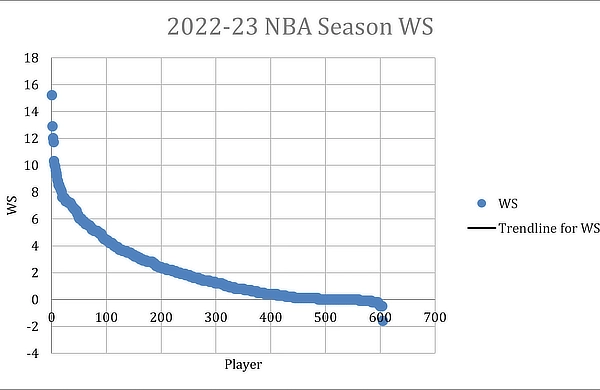
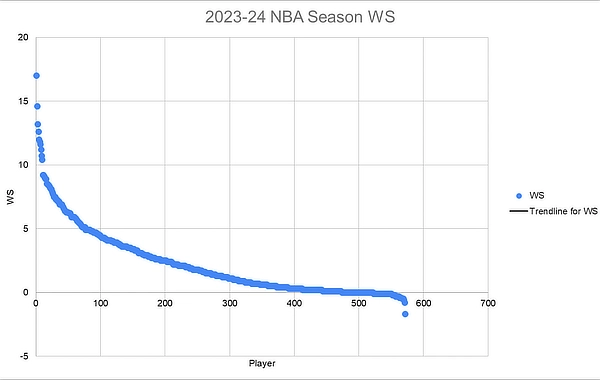
The curve in both graphs is very similar to that formed by a polynomial function to the 10th power. The high R-squared values indicate that it is very heavily correlated, and the fact that 4 different (randomly picked) seasons have similar shapes indicates that this is how Win Shares are usually distributed.
The model then uses the graph's formula (found by averaging the last 10 NBA seasons) to make predictions based on age and experience. Then, it averages these predictions to get a balanced estimate. To refine this estimate, the model also considers the player's current performance, blending it with the predicted values to provide a more realistic forecast. This approach helps ensure that the predictions reflect individual player data and general trends.
Results
Here are the top 25 players in 2029 (according to WS).
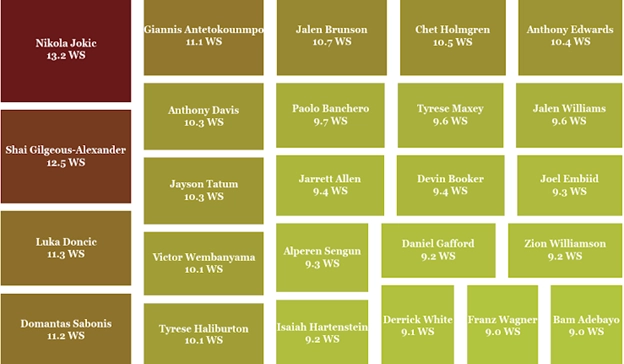
While the top dogs might look familiar—Jokic, Luka, Tatum, and Shai—the youngins will have made their mark. Wembanyama swatting shots into another dimension, Paolo Banchero hitting jaw-dropping midranges, and Haliburton dishing no-look passes that make defenders dizzy. But, because this model is based on last season, somebody like Ja Morant isn't on this chart.
Meanwhile, the legends—LeBron, KD, Steph, Harden, and Kawhi—are riding off into the sunset, leaving the league in the hands of these rising stars. It's a generational takeover, and the model sees it coming like a perfectly timed alley-oop. The message? The NBA's next chapter is in good hands, and the young bloods are ready to write their own legacy. Game on!
Final Thoughts
The model's trying its best, but it's a bit like predicting the weather with just today's temperature—it's only giving us part of the story. Right now, it's all about that single-season data, not accounting for a player's past glory or any possible comebacks. Additionally, the last time a Win Shares (WS) leader had fewer than 14 WS in a full NBA season, David Thompson was rocking the league back in 1977-1978 with 12.7 WS. So, while the rankings might look familiar, the values might be throwing a bit of a curveball.
Here’s the deal: if I get this right and ESPN blows it, fire the entire staff. I’m a 17-year-old high school kid who likes dabbling in sports analytics. Meanwhile, ESPN is packed with grown adults who do this for a living. So yeah, no pressure, right?
Now, let’s talk about who actually should be on this list. Cooper Flagg. Now that's a generational prospect. But, if he ends up on the Pistons or the Wizards (god forbid that happens), we might never hear from him again.
Anyway, I can’t wait to see who everyone thinks got robbed this year. So, who’s your dark horse? Let’s hear it.
Author
Siddhant Jain is a high school senior at the Horace Mann School in the Bronx, NY. Siddhant is extremely passionate about sports analytics and has done a project with the Cleveland Cavaliers this summer.
